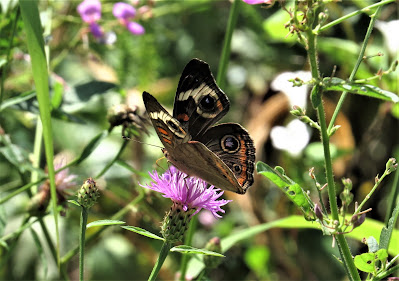Let “Invasive” Plants Do Their Job
ALL TEXT AND PHOTOS © Marlene A. Condon
An edited version
of this article was published April 9, 2021 in the Bay Journal.
“The eye sees only what the mind is
prepared to comprehend”—French philosopher Henri Bergson
The
January-February issue of the Bay Journal reports that nonnative
Hydrilla (Hydrilla verticillata) “has become important in the Bay as a ‘pioneer’
species, colonizing unvegetated areas and making them suitable for native
grasses.” People working for the federal government long ago realized that alien
plants performed better than native plant species to repair degraded
environments, which is why many plants now referred to as “invasive”—such as Autumn
Olive (Eleagnus umbellata)—were brought here. This species helped with mine
reclamation in the 1830s.
Was
it a mistake to bring such plants to this country to help fix man’s destructive
impact upon the environment? No. With an increasing human population accompanied
by development of the land, and increasingly warmer and droughty conditions in places
like Virginia due to manmade global climate change, so-called invasive species would
be the unintended savior for our wildlife—if only folks would take the
time to educate themselves about soil science and how the natural world works.
For
example, it's common to see abandoned fields and roadsides in Virginia filled
with Autumn Olive as you drive throughout the Commonwealth. You could easily
believe the dogmatic precepts that these Asian plants “pushed out” native
plants and took their place, but such erroneous information combined with your deceptive
perception would fool you. Without an assessment of prior use of the land and
knowledge of soils, you can’t possibly come to a reality-based conclusion about
why certain plant species grow in these areas.
Unused
fields formerly accommodated either half-ton cows that trod over them day after
day, or crops that required heavy machinery to prepare the soil, to sow seeds, and
to care for and harvest the plants every year. Roadsides are leftover disturbed
areas following road construction. Both fields and roadsides typically contain nutrient-poor,
compacted soil. Little organic matter was returned to the soil to enrich cow or
crop fields, and topsoil removal by roadway construction uncovered dense subsoil
containing few organisms or nutrients.
Therefore,
the plants you view as you drive along highways bordered by neglected farm
fields are the plants capable of growing well in almost inhospitable conditions
resulting from human activity. They rehabilitate the soil for the benefit of native
plants that require good (i.e., crumbly, nutritive) soil in which to grow well.
Only after the “pioneers” (as with Hydrilla) have done their work can such plants
move into these impaired locations.
Native-pioneer
plant species are few in Piedmont Virginia (where I live), consisting mainly of
Eastern Redcedar (Juniperus virginiana), Virginia Pine (Pinus
virginiana), Eastern White Pine (Pinus strobus, in mountainous and
foothill areas), Broomsedge (Andropogon virginicus), and, though not actually
native to this part of the state, Black Locust (Robinia pseudoacicia). You
will often see these plants joined by Autumn Olive, a hint that supposedly invasive
plants are simply nonnative-pioneer plants, increasing the diversity of plant
life and thus animal life in these areas.
Autumn
Olive shrubs and Black Locust trees in fields and roadsides share an extremely
useful attribute: the ability to fix nitrogen and thus enrich poor soil (a
desirable trait often employed by gardeners growing peas and beans). Such
plants serve as Mother Nature’s nitrogen cooperative, working with soil
bacteria that enrich the soil by adding this vital nutrient to it so people don’t
need to squander oil reserves manufacturing synthetic fertilizer.
Unfortunately,
the predominant narrative nowadays is that everyone must remove supposedly invasive
plants that are mistakenly believed to have displaced native plants while not
offering their ecological benefits to the environment. It’s a false narrative,
but not surprising, given that people are prepared to understand only what
their own biases and limited experiences allow. Yet, anyone can find out for
himself the truth about these plants. It’s not rocket science; you simply need
to observe the natural world without preconceived notions and grow these plants
on your property.
I’ve
observed in my own yard how Black Knapweed (Centaurea nigra), Japanese Honeysuckle
(Lonicera japonica), Autumn Olive, and Paulownia (Paulownia tomentosa)
feed our pollinators with blooms, birds and mammals with fruits/seeds/or buds,
and even furnish nesting material and/or sites. In years when deer
overpopulated the area, they denuded my yard of most native plants, which would
have destroyed all habitat if I hadn’t included commonly disparaged invasives in
my yard that deer didn’t eat. These ungulates are often unrecognized for their
role in making many alien plants appear invasive.
In
the severe drought years of 2002 and 2003, I witnessed how native species
withered alongside the roads as I drove to Shenandoah National Park to give monthly
slide presentations. Meanwhile, alien species continued to flourish despite drought
and drying winds.
If
you care about wildlife, ignore the siren call of voices who frame the
invasive-plant movement in terms of morality (i.e., your “duty” to destroy
these plants). They couldn’t be more wrong.
NATURE ADVICE:
It may not be long before localities begin to
ban the growing of so-called invasive plants on your private property. People
must speak out against such laws that will only bring harm to our wildlife.
Government officials are not experts on this issue; they respond to the people who
make a ruckus. Enlighted citizens must raise their voices so the truth can be
heard and given due consideration.




No comments:
Post a Comment